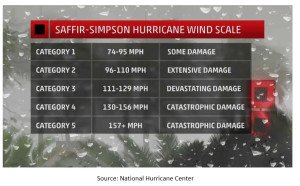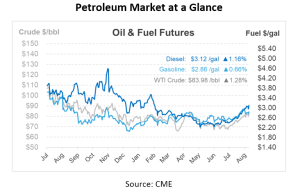
What is it – Saffir-Simpson Hurricane Wind Scale
The 2023 hurricane season recently kicked off in June, as we noted in our FUELSNews article 3 Forecasts to Prepare You. With August being one of the strongest months for hurricane activity, it’s crucial to have an understanding of the different hurricane categories to prepare an emergency plan according to storm severity. Running out of fuel during an emergency could be detrimental to your business. Let’s learn about the different hurricane categories and what they could mean for fuel delivery to help you get ahead of the storms this season.
What is the Saffir-Simpson Hurricane Wind Scale?
The Saffir-Simpson Hurricane Wind Scale is a 1 to 5 rating system that estimates potential property damage from hurricanes based on the hurricane’s sustained wind speed. The scale was developed in the early 1970s by Herbert Saffir, a civil engineer, and Robert Simpson, a meteorologist.
This scale does not incorporate additional severe threats like storm surges, rain-triggered flooding, and tornadoes. All hurricanes generate perilous winds. However, those classified as Category 3 or higher are referred to as ‘major hurricanes.’ The sheer force of the winds from these major hurricanes can cause tremendous to catastrophic damage and substantial loss of life. Regardless of their category, hurricanes can lead to lethal storm surges, flooding induced by heavy rainfall, and tornadoes. These risks necessitate preventative measures, including evacuation from areas susceptible to storm surges. As a rule of thumb, the damage typically multiplies roughly fourfold with each category increase.
Hurricane Wind Categories
Here is a breakdown of the categories and the sustained wind speeds associated with each:
Category 1: Winds from 74 to 95 mph. Damage may be inflicted on unanchored mobile units, shrubbery, and trees, while well-constructed frame homes could experience damage to roofs, shingles, vinyl siding, and gutters.
Category 2: Winds from 96 to 110 mph. There can be significant roof and siding damage to houses, many trees could be uprooted or snapped, and near-total power loss is expected, with outages lasting from several days to weeks.
Category 3 (Major): Winds from 111 to 129 mph. There can be devastating damage to homes, many trees will be uprooted or snapped, and electricity and water will likely be unavailable for several days to weeks after the storm passes.
Category 4 (Major): Winds from 130 to 156 mph. There can be catastrophic damage to homes; most trees will be snapped or uprooted, power poles will be downed, power outages will last for weeks to possibly months, and most of the area will be uninhabitable for weeks or months.
Category 5 (Major): Winds 157 mph or higher. Catastrophic damage will occur, a high percentage of homes will be destroyed, power outages will last for weeks to possibly months, and most of the area will be uninhabitable for weeks or months.

What do these categories mean for my fuel delivery?
Beginning with the highest storm level, a category 5, markets are commonly directly affected, ranging from truck availability and delivery infrastructure to the safe delivery of fuel products being hindered until the situation improves. Major hurricanes, classified as categories 3-5, also significantly impact markets, often impeding fuel and freight operations, thus necessitating delays in delivery or alternative fuel supply methods.
There are various strategies your business can adopt to remain prepared for such storms and maintain steady fuel supplies. Here are some considerations for readiness in case of an emergency situation:
- Collaborate with your fuel provider to ensure all tanks and vehicles are filled to their maximum capacity.
- Begin utilizing retail fuel ahead of the storm, and resort to any reserves once retail options become unavailable.
- Contact your fuel supplier before an emergency to discuss your contingency plan for fuel supply.
- Think about pre-contracting dedicated assets to sustain operations while the supply and carrier capacity is constrained.
We urge everyone to be equipped with a plan for emergency fuel situations. If you feel underprepared, or if your current fuel provider does not provide these services and advice, don’t hesitate to contact the Mansfield team.

This article is part of Daily Market News & Insights
Tagged:
MARKET CONDITION REPORT - DISCLAIMER
The information contained herein is derived from sources believed to be reliable; however, this information is not guaranteed as to its accuracy or completeness. Furthermore, no responsibility is assumed for use of this material and no express or implied warranties or guarantees are made. This material and any view or comment expressed herein are provided for informational purposes only and should not be construed in any way as an inducement or recommendation to buy or sell products, commodity futures or options contracts.





